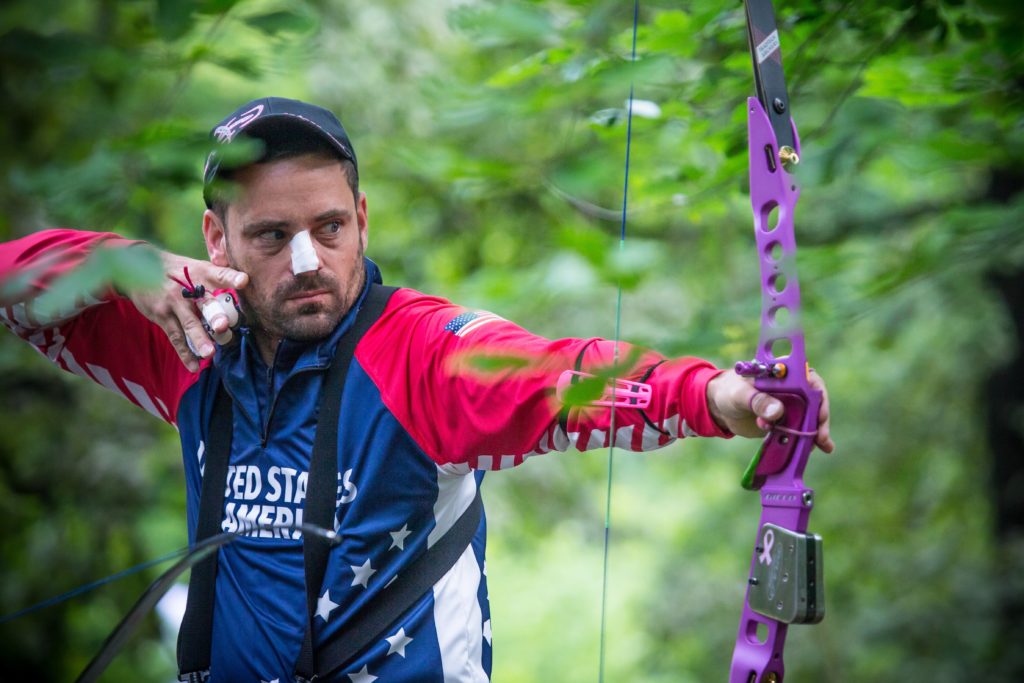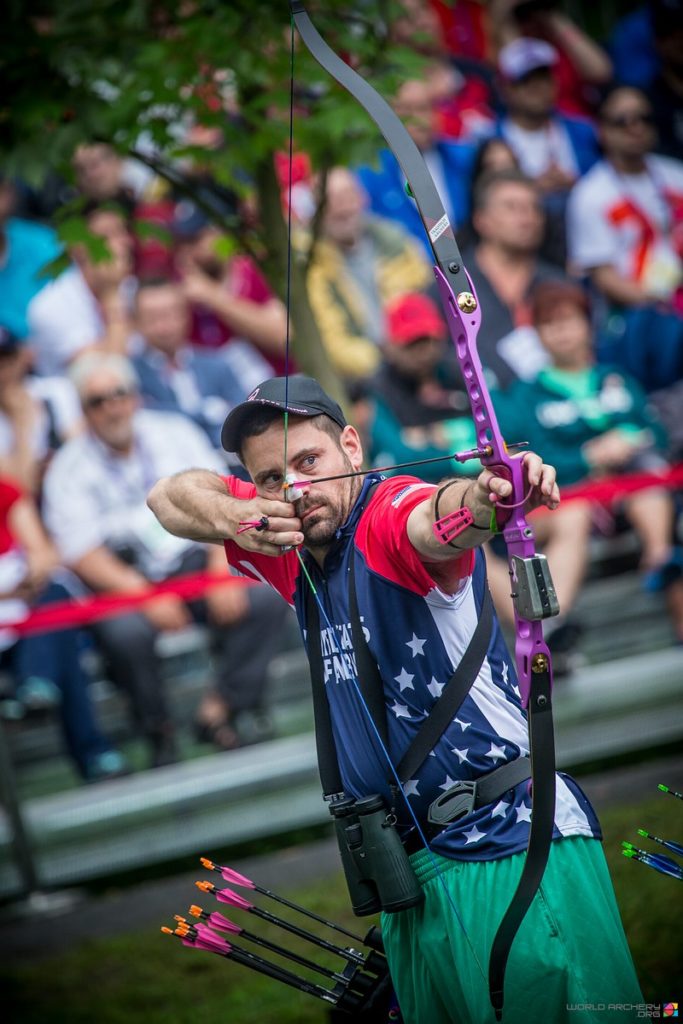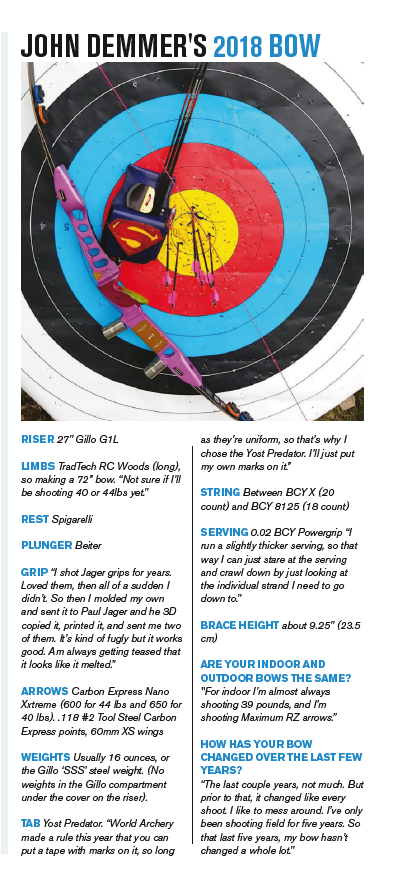Top USA barebow archer John Demmer III talks to Danielle Gerken about his hopes going into the 2018 World Field Championships – and his vision for the future of the sport.
Like many US archers, John Demmer grew up around hunting. Every year his
cousin would come up to see him and go bowhunting. After thinking it unfair that his cousin got to shoot a bow two months earlier than he did, he picked up a compound bow and joined him.
In 1998, Demmer was out shooting targets with a friend who shot barebow, who was teasing him about how much harder it was to shoot. That’s when Demmer immediately switched to the discipline.
Since then, Demmer has shot his way up to the top, earning a gold medal in Dublin in 2016 for the team field competition and an individual silver the following year at the World Games – the closest a barebow archer can get to the Olympics. “It was quite the relief when I ended up working through my shoot-ups to get into that spot,” he says about earning silver in 2017. “Unfortunately I didn’t shoot well enough in the final match, but it was pretty cool to shoot well in front of people to get the growth and interest up even more.”
When asked about how it felt to be the first non- European medalist at the World Games, Demmer responded with a characteristic “it was very cool.” He has remained the top barebow archer at the USA indoor nationals for five years in a row, and goes into the World Championships in Cortina as one of the favourites for gold, although he is distinctly modest about his achievements, crediting luck or good teammates more often than skill.
Demmer has managed to achieve all this despite an extremely low training volume. During the off season, he will only shoot about a hundred arrows a week – if he feels like shooting at all. About a month and a half before a competition, he will slowly increase the volume until about two to three weeks before a competition where he will shoot about two hundred arrows, three to four times a week. “Like anything in life, the more you do something, the easier it gets. Almost as if you were born to do it.”
Even if he is out shooting, it isn’t a guarantee that he’ll be shooting barebow. Some days, he’ll go out with a compound – to make himself “feel more honest” about his form. “If I made a mistake on the form side with a compound, it is 100% conclusive, there wasn’t no ‘well I wonder if it was just the left arrow of the group.’ So I feel like shooting a compound every once in awhile improves your technique and improves your self-awareness.”
Barebow field archery is much more prevalent in Europe, giving his main competition a huge advantage. The discipline doesn’t provide enough in prizes to allow archers to pursue the passion full-time and make a career out of it, and Demmer makes his living at a stone quarry. (He is self-employed, so that he can make his schedule work around shoots). He also eschews many other field archery traditions, competing in lurid colours.
Although Demmer consistently outperforms most other archers, he claims his main focus isn’t about winning, it’s about bringing attention to the sport.
“Hopefully it gives the US some more motivation to do things, to maybe slap their ego around a little bit. Last year less than fifty archers competed in the US field tournament, this year more than eighty archers showed up. [Medaling] works to that benefit of keeping the interest moving forward.”
He claims to look at every competition to help him and the division grow, especially in the USA. “The thing I’m most proud of is the consistency while also helping others to get better and hopefully, eventually, give me a good beat down.”
The definition of the word ‘barebow’ isn’t fixed, at least for international archers. The NFAA permits a barebow shooter to use stabilisers and a clicker, provided that the back stabiliser doesn’t touch the body and the clicker doesn’t extend a quarter of an inch above the arrow. World Archery allows neither of these.
Because of the difficulties barebow archers have with field archery, Demmer thinks it is difficult to get most archers off of targets. However, once they have tried field archery, “the vast majority of them are hooked.”
Why shoot barebow rather than trad? “There is greater growth in the barebow community, which is leading to a more competitive group. There really isn’t the same amount of opportunities in trad as there are in barebow. Barebow we have field and 3D worlds, and the World Games to participate in for World Archery and bowhunter worlds and field worlds for IFAA. You don’t get that in trad.”
“For Cortina, the barebow class will be very strong with several past world champions and some new players coming up. It’s really difficult to say who will be the biggest contenders since we have a new format this year.”
“As for the top qualifying scores, I would expect to see the normal names of David Garcia, Martin Ottosson, and Eric Jonsson to be right up there battling for the two automatic semifinal seeds.”
Demmer looks at the Worlds as an opportunity
to meet with other archers, tapping into the deep international barebow fraternity. “You’re getting a lot of the upper-end skilled archers. So it’s best to learn those things and bring them back and share them with others, especially those who won’t have the opportunity to experience, that so you can pass on the knowledge.”
This collaborative approach actually informed his own shooting style. During his earlier years, Demmer found himself shooting in a sort of team match in an IBO competition with three strangers. “That ended up being a blessing in disguise for the form development.” Over time, they developed a close bond and started to bounce ideas off of each other on how to fix issues that arose while shooting. “I went from getting my butt handed to me shooting split finger instinctive to shooting relatively well just by talking to people.”
When it comes to improvement, Demmer’s biggest advice is to “not be afraid to ask questions.” Demmer says that this is especially true for barebows, and he practices what he preaches: whether it’s a technical Facebook post asking about minute details of how number of string affect the spine of the arrow, or something as general asking about the basics of string walking will, he is proud to provide all of the resources he has gathered to help provide a comprehensive answer to the question. His recent barebow seminar at Lancaster Archery was standing room only.
For him, ultimately it isn’t about being able to shoot just one more match, one more end, one more arrow. The end game is “what the final look for barebow is.” He is a very public expression of the sport’s fraternal nature. “I could go up to my top competitor and bounce questions off them, and they would be more than willing to help me out.”
“That’s the part of the sport I like the most.”





I agree 200% with the comments regarding field shoots. My temporary conclusion (oxymoron?) is that it is too difficult. Not a dig at any one, just an observation. Truth be told, shooting bare bow at 50-60 yds is no walk in the park. Or is it ? It’s a field shoot. Oh, whatever. I re-established my state’s charter with NFAA to utilize our lovely 28 target field course and the interest has been very under whelming. Some of it is simply organizational/coordinating, but it does not seem that folks shoot field very much. At least at our club. I truly, truly believe that is not the case elsewhere. I would LOVE to see more folks at our field shoots. Here’s the idea behind my long-windedness here – It would be terrific to have a field shoot site to go to to check for shoots. If it already exists, please tell me where. To John, please, please keep up the good work and the enthusiasm … it is spreading faster than you think 🙂 See you at the Lancaster Classic … not sure whether I will be competing or watching … but I’ll be there nonetheless … Signing off for now …